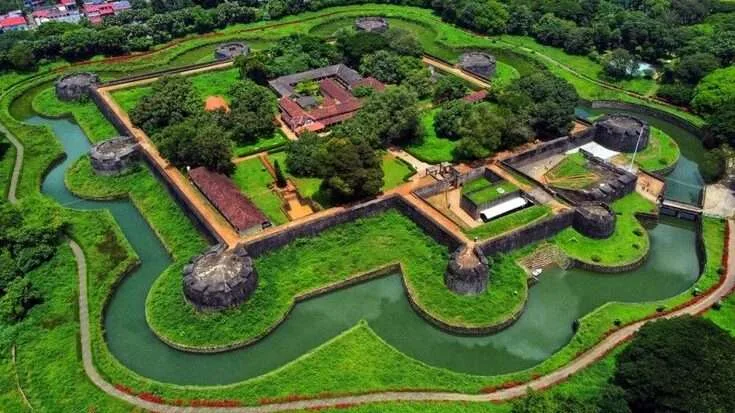Palakkad Fort
Palakkad Post, settled within the heart of Palakkad city in Kerala, stands as a confirmation to the structural brilliance and key significance of bygone times. Known for its verifiable and social importance, this well-preserved fortification proceeds to draw in history devotees, sightseers, and researchers alike. In this article, we dive profound into the roots of Palakkad Fort, the reasons behind its development, and its persevering bequest.
When Was Palakkad Fort Built?
Palakkad Post, too known as Tipu’s Fortification, was developed in 1766 Advertisement by Hyder Ali, the ruler of the Mysore Kingdom. This period stamped a time of strongly military action and regional development in South India. Hyder Ali’s desire to set up control over the locale driven to the fort’s development, making it a urgent protective structure in his campaign against the British East India Company and other territorial powers.
Palakkad Fort Location on Google
Why Was Palakkad Fort Built?
The key area of Palakkad Post played a vital part in its development. The post was built for a few key reasons:
1. Key Military Advantage
Palakkad Fortification is arranged at the door to Kerala, particularly the Palakkad Hole, a normal pass within the Western Ghats. This geographic highlight has generally been a crucial exchange and military course interfacing the fields of Tamil Nadu with the coastal locales of Kerala. By controlling this entry, Hyder Ali seem viably screen and direct movement, ensuring his dominance within the locale.
2. Defense Against Rivals
Hyder Ali built the post as a fortress to secure his kingdom from attacks by the British East India Company and other territorial enemies. The vigorous structure of the post, total with thick stone dividers and well-planned bastions, served as a imposing defense instrument.
3. Regulatory and Military Base
The post too worked as an regulatory center and a military battalion. It housed soldiers, ammo, and supplies, empowering Hyder Ali to preserve his specialist and carry out operations productively.
4. Image of Control
Past its military and authoritative purposes, Palakkad Fortification symbolized Hyder Ali’s control and impact. Its forcing design passed on a message of quality and versatility, preventing potential challengers.
Architectural Features of Palakkad Fort
The design of Palakkad Fortification reflects a mix of conventional South Indian and military designing styles. Key highlights incorporate:
- Square Format: The post is built in a square shape, a common include of posts built for vital purposes.
- Thick Rock Dividers: These dividers, strengthened with stone and mortar, have stood the test of time and proceed to wonderment guests.
- Channel: Encompassing the fortification could be a wide and profound canal, outlined to obstruct adversary propels and make the structure impervious.
- Bastions and Passages: The fortification has solid bastions at its corners and well-planned passages, guaranteeing most extreme security and ease of development for its tenants.
- Sanctuaries and Silos: Inside the post premises, there are sanctuaries and storage facilities, highlighting its part as a self-sustained foundation amid times of attack

British Occupation and Restoration Efforts
In 1784, the British East India Company captured Palakkad Fortification taking after their triumph over Tipu Sultan, Hyder Ali’s successor. The fortification served as a military base for the British, who made a few alterations to suit their needs. In spite of changing hands, the fortification remained a key military establishment amid colonial run the show. Post-independence, the Archeological Overview of India (ASI) took over the post and attempted broad reclamation endeavors. Nowadays, it stands as a ensured landmark, displaying the region’s wealthy history and building legacy.
Significance of Palakkad Fort Today
Palakkad Post holds monstrous authentic, social, and structural noteworthiness. Here’s why it remains a cherished point of interest:
- Traveler Fascination: The fortification could be a prevalent goal for sightseers and history buffs, advertising a see into the region’s past.
- Social Center: The post premises have different social occasions, presentations, and exhibitions, celebrating Kerala’s dynamic legacy.
- Instructive Esteem: The post serves as an instructive asset for understudies and analysts considering South Indian history and engineering.
- Serene Withdraw: The rich greenery and quiet climate around the post make it an perfect spot for unwinding and relaxation.
Visiting Palakkad Fort
Location:
Palakkad Fortification is found within the heart of Palakkad city, effortlessly available by street, rail, and discuss. The closest railroad station, Palakkad Junction, is fair some kilometers absent, whereas Coimbatore Universal Airplane terminal serves as the closest discuss center.
Timings:
The fortification is open to guests from 9:00 AM to 6:00 PM on all days of the week. Section is free, making it an reasonable however enhancing involvement for all.
Best Time to Visit:
The finest time to visit Palakkad Fortification is amid the winter months, from October to Walk, when the climate is charming and conducive to investigating the post and its environment.
Conclusion
Palakkad Fortification stands as a signal of history, exhibiting the building resourcefulness and vital premonition of its builders. Built in 1766 by Hyder Ali, the fort’s persevering bequest could be a confirmation to its chronicled significance and social centrality. Nowadays, it proceeds to rouse wonder and deference, drawing visitors from around the world. Whether you’re a history devotee, a social pilgrim, or essentially a traveler looking for tranquility, Palakkad Post guarantees a travel back in time. Its grand structure, wealthy history, and peaceful environment make it a must-visit goal for anybody investigating the charming state of Kerala.
Author Bio: This article was crafted by a history enthusiast with a deep passion for uncovering India’s architectural and cultural treasures. Drawing from reliable sources and personal exploration, the author aims to provide an engaging and informative perspective on Palakkad Fort. All information is cited and verified for accuracy.


